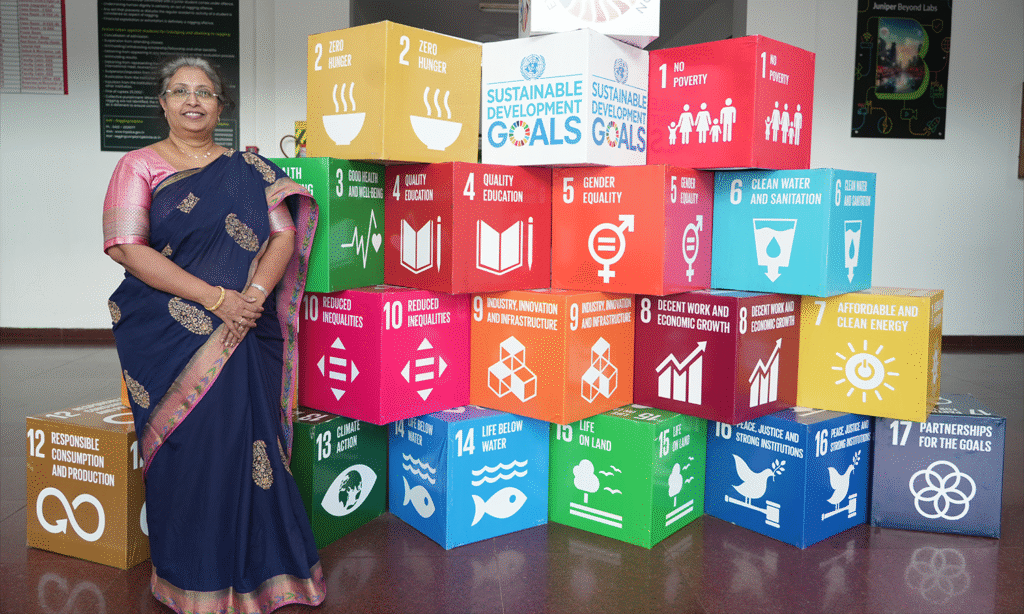


Higher Education Institutions today are centres of academic excellence and drivers of social transformation uniquely positioned to lead change Sustainable Development Goals (SDGs) linking most importantly, to community engagement.
Higher Education Institutions today are centres of academic excellence and drivers of social transformation uniquely positioned to lead change Sustainable Development Goals (SDGs) linking most importantly, to community engagement.

Why Measuring Impact is Essential? Why Measurement Matters? How do we measure impact? What are the approaches to Track SDG Impact? How do HEIs ensure that their outreach is not just activity, but transformation? How MapSDG Powers Measuring Impact?
A few practical ways HEIs can track their contribution to the SDGs through outreach and community
Outreach programs often focus on activities/initiatives such as health camps, awareness drives, clean-up campaigns, or skill-building workshops. All these initiatives are very valuable to HEIs, their success cannot be determined by counting events or participants alone. Impact measurement is about understanding change in knowledge, behavior, policy, or quality of life.
Awareness campaigns, village visits, or skill-building programs organized for outreach are often celebrated with photos and reports. But the key question remains: Did they create lasting change? Impact measurement ensures that HEIs move beyond tokenism to genuine transformation.

Measuring impact means going beyond recording activities or outputs to assess the real difference created in people’s lives, systems, and environments. It answers: What changed because of our intervention? What changed because of our approach?
Start by linking programs to specific goals, such as the SDGs. For example, a clean water initiative may target SDG 6 (Clean Water and Sanitation).
Indicators can be quantitative (e.g., number of households with safe drinking water) or qualitative (e.g., community perception of water quality).
Involve communities, students, and local partners in defining what success looks like. This ensures that measurement reflects real needs, not just institutional priorities.
Combine surveys, focus groups, participatory tools, and digital dashboards to capture both data and lived experiences.
Outputs are immediate results (like training 100 women). Outcomes are long-term changes (like 60 women securing sustainable income).
Follow up months or years later to see if the changes last—improved health, sustained livelihoods, or stronger institutions.
Share findings transparently, highlighting both successes and gaps, so strategies can evolve for greater impact.


Outcome Mapping is a powerful approach that shifts the focus from counting activities to assessing real change. Instead of measuring only inputs (like the number of workshops) or outputs (like the number of participants), it looks at outcomes — any change in behavior, attitudes, or practices among communities and stakeholders.
For example, after a sanitation campaign, the true measure is whether households adopt hygienic practices, not just how many attended the session. In academic settings, it examines whether students apply critical thinking and social responsibility beyond the classroom.
Thus, Outcome Mapping captures transformation, not just statistics, ensuring sustainable impact.
Community-centered metrics place the voices and experiences of local people at the heart of impact measurement. Instead of institutions imposing definitions of success, communities co-create indicators that reflect their real needs and aspirations.
For instance, in a sanitation project, the institution might record the number of workshops, but the community may define success as reduced open defecation, cleaner surroundings, or fewer waterborne diseases.
This approach ensures accountability, relevance, and ownership. It also fosters trust, as people see their lived realities valued in assessment. Ultimately, community-centered metrics align SDG tracking with the actual improvements communities want to sustain.
Longitudinal tracking involves monitoring changes long after an intervention has taken place to assess whether benefits are sustained over time. Short-term gains may look impressive in reports, but only follow-ups reveal real impact.
Example: A livelihood training program may initially show high placement rates, but longitudinal tracking checks if participants are still employed or earning after six months or a year. Similarly, environmental projects can be evaluated by survival rates of trees planted, improved biodiversity, or lasting reductions in waste.
By embedding long-term evaluation, HEIs ensure that their outreach generates durable transformation rather than temporary outcomes.

MapSDG, an AI-driven sustainability platform, enables HEIs to capture quantitative impact from outreach and community engagement initiatives effectively.
Examples:
Examples:
(Source: University reports & outreach documentation)
(Source: IIT Delhi & NDTV report, 2023)
By providing numerical evidence of change, MapSDG helps HEIs move from activity-based outreach to measurable, scalable impact. Institutions can quantify their contributions to the SDGs, track improvements over time, and demonstrate accountability, ensuring outreach initiatives deliver real-world transformation.